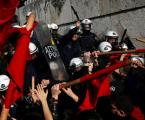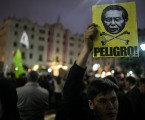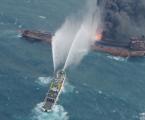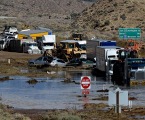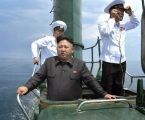RMS Titanic was a British passenger and mail carrying ocean liner, operated by the White Star Line, that sank in the North Atlantic Ocean on 15 April 1912 as a result of striking an iceberg during her maiden voyage from Southampton, England, to New York City, United States. Of the estimated 2,224 passengers and crew aboard, about 1,500 died, making it the deadliest sinking of a single ship up to that time. The disaster drew public attention, spurred major changes in maritime safety regulations, and inspired many artistic works. RMS Titanic was the largest ship afloat at the time she entered service and the second of three Olympic-class ocean liners built for the White Star Line. She was built by the Harland and Wolff shipbuilding company in Belfast. Thomas Andrews Jr., the chief naval architect of the shipyard, died in the disaster. Titanic was under the command of Captain Edward John Smith, who went down with the ship. The ocean liner carried some of the wealthiest people in the world, as well as hundreds of emigrants from the British Isles, Scandinavia, and elsewhere throughout Europe, who were seeking a new life in the United States and Canada.
The Bab EL Mandeb – An important and busy shipping route
The Bab-el-Mandeb the Gate of Grief or the Gate of Tears, is a strait between Yemen on the Arabian Peninsula, Djibouti, and Eritrea in the Horn of Africa. It connects the Red Sea to the Gulf of Aden and by extension the Indian Ocean.
Name
The strait derives its name from the dangers attending its navigation or, according to an Arab legend, from the numbers who were drowned by an earthquake that separated the Arabian Peninsula from the Horn of Africa. In “Bab-el-Mandeb”, “Bab” means “gate” while “Mandeb” means “lamentation” or “grief”.
Geography
The distance across is about 26 kilometres (16 mi) from Ras Menheli in Yemen to Ras Siyyan in Djibouti. The island of Perim divides the strait into two channels, of which the eastern, known as the Bab Iskender (Alexander’s Strait), is 5.37 kilometres (3.34 mi) wide and 29 metres; 96 feet (16 fathoms) deep, while the western, or Dact-el-Mayun, has a width of 20.3 kilometres (12.6 mi) and a depth of 310 metres; 1,020 feet (170 fathoms). Near the coast of Djibouti lies a group of smaller islands known as the “Seven Brothers”. There is a surface current inwards in the eastern channel, but a strong undercurrent outwards in the western channel.
Significance in the maritime trade route
The Bab-el-Mandeb acts as a strategic link between the Indian Ocean and the Mediterranean Sea via the Red Sea and the Suez Canal. Most exports of petroleum and natural gas from the Persian Gulf that transit the Suez Canal or the SUMED Pipeline pass through both the Bab el-Mandeb and the Strait of Hormuz. Under the purview of the article 37 of the United Nations Convention on the Law of the Sea, the legal concept of transit passage applies to Bab el-Mandeb, although Eritrea (unlike the rest of coastal countries) is not a party to the convention. Chokepoints are narrow channels along widely used global sea routes that are critical to global energy security. The Bab el-Mandeb Strait is 18 miles wide at its narrowest point, limiting tanker traffic to two 2-mile-wide channels for inbound and outbound shipments. Closure of the Bab el-Mandeb Strait could keep tankers originating in the Persian Gulf from transiting the Suez Canal or reaching the SUMED Pipeline, forcing them to divert around the southern tip of Africa, which would increase transit time and shipping costs. In 2006, an estimated 3.3 million barrels (520,000 m3) of oil passed through the strait per day, out of a world total of about 43 million barrels per day (6,800,000 m3/d) moved by tankers. In 2018, an estimated 6.2 million barrels per day (b/d) of crude oil, condensate, and refined petroleum products flowed through the Bab el-Mandeb Strait toward Europe, the United States, and Asia, an increase from 5.1 million b/d in 2014. Total petroleum flows through the Bab el-Mandeb Strait accounted for about 9% of total seaborne-traded petroleum (crude oil and refined petroleum products) in 2017. About 3.6 million b/d moved north toward Europe; another 2.6 million b/d flowed in the opposite direction mainly to Asian markets such as Singapore, China, and India.
History
Paleo-environmental and tectonic events in the Miocene epoch created the Danakil Isthmus, a land bridge forming a broad connection between Yemen and Ethiopia. During the last 100,000 years, eustatic sea level fluctuations have led to alternate opening and closing of the straits. According to the recent single origin hypothesis, the straits of Bab-el-Mandeb were probably witness to the earliest migrations of modern humans. It is presumed that the oceans were then much lower and the straits were much shallower or dry, which allowed a series of emigrations along the southern coast of Asia. According to Ethiopian Orthodox Tewahedo Church tradition, the straits of Bab-el-Mandeb were witness to the earliest migrations of Semitic Ge’ez speakers into Africa, occurring c. 1900 BC, roughly around the same time as the Hebrew patriarch Jacob. The Kingdom of Aksum was a major regional power in the Horn of Africa. It extended its rule across the strait with the conquest of the Himyarite Kingdom shortly before the rise of Islam. The British East India Company unilaterally seized the island of Perim in 1799 on behalf of its Indian empire. The government of Britain asserted its ownership in 1857 and erected a lighthouse there in 1861, using it to command the Red Sea and the trade routes through the Suez Canal.
It was used as a coaling station to refuel steamships until 1935 when the reduced use of coal as fuel rendered the operation unprofitable. The British presence continued until 1967 when the island became part of the People’s Republic of South Yemen. Before the handover, the British government had put forward before the United Nations a proposal for the island to be internationalized as a way to ensure the continued security of passage and navigation in the Bab-el-Mandeb, but this was refused. In 2008 a company owned by Tarek bin Laden unveiled plans to build a bridge named Bridge of the Horns across the strait, linking Yemen with Djibouti. Middle East Development LLC issued a notice to construct a bridge passing across the Red Sea that would be the longest suspended passing in the world. The project was assigned to engineering company COWI in collaboration with architect studio Dissing+Weitling, both from Denmark. It was announced in 2010 that Phase 1 had been delayed; however, as of mid-2016, nothing more has been heard about the project.
Sub-region
The Bab-el-Mandeb is also a sub-region in the Arab League, which includes Djibouti, Yemen, and Eritrea.
Source : Wikipedia
<
p style=”text-align: justify”>
Ayman Mohyeldin – Egyptian-born political commentator
Ayman Mohyeldin is an Egyptian-born political commentator based in New York for NBC News and MSNBC. Previously the anchor of an MSNBC weekday afternoon show, Ayman Mohyeldin Reports (formerly MSNBC Live with Ayman Mohyeldin), he currently hosts Ayman on weekend evenings on MSNBC, and Fridays on Peacock. He previously worked for Al Jazeera and CNN. He was one of the first Western journalists allowed to enter and report on the handing over and trial of the deposed President of Iraq Saddam Hussein by the Iraqi Interim Government for crimes against humanity. Mohyeldin has also covered the 2008–09 Gaza War as well as the Arab Spring.
Motaz Azaiza – Palestinian photojournalist from the Gaza Strip
Motaz Hilal Azaiza is a Palestinian photojournalist from the Gaza Strip.
Early life and education
Azaiza was raised in the Deir al-Balah Camp in the Gaza Strip. He attended Al-Azhar University in Gaza, graduating in 2021 with a degree in English studies. He is currently employed by UNRWA.
Photojournalism
Prior to the 2023 Israel–Hamas war, Azaiza’s online posts most focused on photographing daily life in his native Gaza Strip. Although he covered the 2014 Gaza War and the 2021 Israel–Palestine crisis, his social media accounts did not gain much attention. There are few foreign journalists in the Gaza Strip due to Israel and Egypt denying them access to the territory, which has led to Azaiza becoming a key reporter on the ground in Gaza. Prior to the Hamas-led attack on Israel on 7 October 2023, Azaiza’s profile on Instagram had approximately 25,000 followers. On 13 October, his Instagram account was restricted, but access was restored the following day. His follower count had increased to one million by 17 October, nine million by October 30, 12.5 million by November 3, and 13 million by November 7. As of 24 December 2023, Azaiza’s Instagram profile had 17.5 million followers. In November 2023, GQ Middle East named him as their Man of the Year, with editor Ahmad Ali Swaid stating that “he reminds us that no matter who we are or where we’re from, it’s us – ordinary people, men, and women – who have the power to enact that very change that we want to see.”
Personal life
On 11 October 2023, at least 15 of Azaiza’s relatives were killed in an Israeli airstrike on the Deir al-Balah Camp, shortly after the outbreak of the 2023 Israel–Hamas war.
Sir William Mark Tully – former Bureau Chief of BBC, New Delhi
Sir William Mark Tully, is the former Bureau Chief of BBC, New Delhi, a position he held for 20 years. He worked with the BBC for a total of 30 years before resigning in July 1994. The recipient of several awards, Tully has authored nine books. He is a member of the Oriental Club.
The deadliest war for journalists in decades
As of 10 December 23, at least 63 journalists (56 Palestinian, 4 Israeli and 3 Lebanese) have been killed
during the 2023 Israel–Hamas war, alongside other violence against journalists, making it the deadliest period for journalists in the Israeli–Palestinian conflict since 1992 and the deadliest start of a war in the 21st century for journalists. By 6 December, it was believed to be the deadliest war for journalists in decades. An estimated 48 media facilities in Gaza have been damaged or destroyed by Israeli airstrikes. Reporters Without Borders claimed that the Israeli army had deliberately targeted Palestinian and Lebanese journalists.
Wael Al-Dahdouh, Palestinian journalist and the bureau chief of Al Jazeera
Early life and education
Peace Through Media Award (2013) by the International Media Awards in London.
Al Jazeera English is a 24-hour English-language news channel
Al Jazeera English is a 24-hour English-language news channel. It operates under the ownership of the
Al Jazeera Media Network, which, in turn, is funded by the government of Qatar. It is the first English-language news channel to be headquartered in Western Asia. Al Jazeera broadcasts in over 150 countries and territories, and has a large global audience of over 430 million people. Al Jazeera is known for its in-depth and frontline reporting, particularly in conflict zones. It has been praised for its in-depth coverage of events such as the Arab Spring and the Gaza–Israel conflict. Al Jazeera’s coverage of the Arab Spring won the network numerous awards, including the Peabody Award. The channel was launched on 15 November 2006, at 12:00 pm GMT. Although it had initially aimed to commence broadcasting in June 2006, the launch had to be postponed due to the unavailability of its HDTV technology, which was not yet ready at that time. The channel was initially slated to be named Al Jazeera International, but the name was changed nine months before the launch. This decision was influenced by one of the channel’s backers who argued that the original Arabic-language channel already encompassed an international scope.
Mehdi Raza Hasan is a British-American broadcaster and author
Mehdi Raza Hasan was born in Swindon to immigrant Indian Hyderabadi Muslim parents from the city of Hyderabad in Andhra Pradesh, South India (now in Telangana). Hasan was privately educated at Merchant Taylors’ School, Northwood, a day independent school for boys at Sandy Lodge in the Three Rivers District of Hertfordshire, near the town of Northwood in North West London. He then attended Christ Church, Oxford, where he read Philosophy, Politics and Economics (PPE), and graduated in 2000.
Career
Inside the NATO summit

